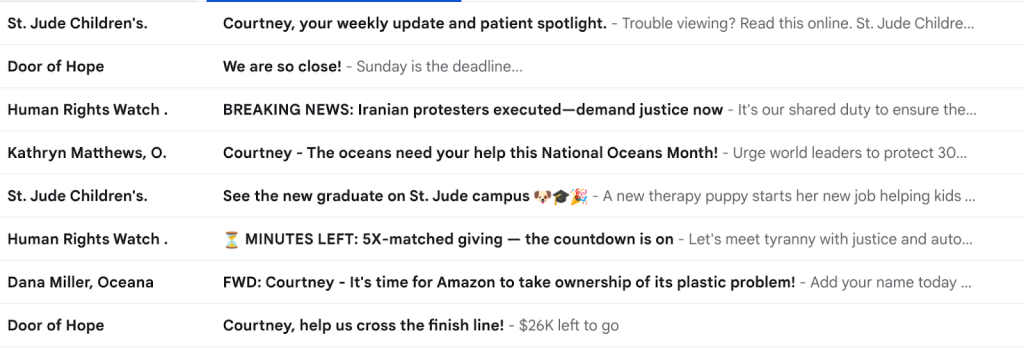Subject lines to grab your donors’ attention
By Courtney Hamilton, Writer
If you want to maximize your nonprofit’s fundraising efforts, writing effective email subject lines is a must. Like an eye-catching envelope you send for a direct mail appeal, a subject line is your first opportunity to stand out in someone’s email inbox.
According to a recent study by Neon One, the average nonprofit raises nearly $6,000 per email campaign, and the average nonprofit email open rate is 7% higher than the for-profit average.
That’s great news for nonprofits! But how do you leverage this higher open rate? It all starts with a great nonprofit email subject line… an important first impression that determines whether someone clicks your email open. Keep reading for simple tweaks you can make to your subject lines for better results!
Make your subject line scannable and eye-catching.
Think of your subject line like a headline. It needs to grab your readers’ attention and make them want to learn more about what you’re offering inside.
Consider these real examples of nonprofit email subject lines that popped up in my inbox recently. Which ones draw your eyes’ attention? Which ones would you click on?

My eyes immediately go to a few places…
- Emojis: Who can resist a cute puppy emoji? In a wall of text in your inbox, emojis help stand out visually. But a word of advice: Use emojis strategically and think about how they’ll look in a mobile inbox. Consider moving them to the beginning of your subject line so they don’t get cut off. You can easily copy and paste emojis into your subject line with a tool like Emojipedia.
- Capitalization: Words that are capitalized – especially at the beginning of a subject line – are hard to miss. Paired with urgent language like, “MINUTES LEFT” or “BREAKING NEWS” makes this tactic particularly effective.
- Name personalization: It’s hard to completely ignore a subject line that begins with your own name. Many email platforms are able to pull in the first name or other data of your linked donor database (and if your platform can’t do that, it’s time to make an email platform switch!). Take advantage of this feature when you want to speak more personally or directly to your audience.
Take subject line personalization beyond the name.
Because it’s easy to pull in a name as personalization, more organizations and brands in your audience’s inbox will also do it. Look for ways to really set your subject line apart with even more ways to customize.
For example, if you’re seeking support for a service you provide in a specific area, consider including the name of your donors’ city or state in the subject line, like this email I received from Oceana:

Localization isn’t limited to service area names. You could also mention specific features only a person in that area might know… like current temperatures or neighborhood names.
If you’re writing to a specific audience or niche, using a specific term to address them in your subject line directly is a great way to get your email opened. According to SubjectLine.com, here are just a few of the top personalization tactics marketers are using today to increase open rates:
Test your nonprofit email subject lines.
There are so many options for spicing up your nonprofit email subject line, but it can be hard to know which ones will actually result in higher open and click rates and conversions. That’s why it’s important to test your email subject lines.
At BDI, we are constantly running A/B tests on the subject lines we use for our nonprofit partners’ emails, where we send the same email content with two unique subject lines to see what performs best. What worked last year doesn’t always work the next. Subject line strategies are often changing, so it’s important to keep a pulse on the most effective tactics within your audience.
Consider testing messaging (urgent vs. emotional), length (long vs. short) or other factors (emojis vs. no emojis, capitalization vs. text in brackets). See what your audience responds to the most and adjust from there. You can even test including specific words in your subject lines to see what impacts open rates, like Neon One did:
Wondering where to start with subject line testing? Tools like SubjectLine.com can help you determine how effective a potential subject line will be – and it uses AI integration and the latest subject line testing data to offer you suggestions for improvement and possible tests to run. Bookmark it today!
Don’t forget about preview text.
Even if your subject line is eye-catching, many email platforms will show additional preview text below the headline. Don’t let this extra real estate go to waste… or worse, allow your email platform to pull in any technical text it wants!
Take control of what appears in the preview text and use it as an opportunity to further motivate your audience to open your email. Consider including an additional call to action, or including emojis in the preview text (especially if you didn’t include them in your subject line).
Looking back at my email inbox example, notice how the best preview text examples (highlighted yellow) complement and even enhance the subject lines’ messaging:

Keep your (subject line) promises.
When you write a subject line, make sure that the content inside is something people will care about. If you promise an important update or call to action in your subject line, deliver on it with useful information and clear instructions for how the reader can help support your cause inside.
Follow these tips and watch your nonprofit email open and click rates climb! Need help to craft the perfect subject line for your next email campaign? Send me an email and I’d love to help you brainstorm.





